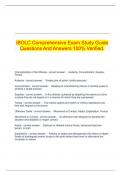IBOLC Comprehensive Exam Study Guide
Questions And Answers 100% Verified.
Characteristics of the Offense - correct answer. Audacity, Concentration, Surpise,
Tempo
Audacity - correct answer. Simple plan of action, boldly executed
Concentration - correct answer. Massing of overwhelming effects of combat power to
achieve a single purpose
Surprise - correct answer. In the offense, achieved by attacking the enemy at a time
or place they do not expect or in a manner for which they are unprepared
Tempo - correct answer. The relative speed and rhythm of military operations over
time with respect to the enemy
Offensive Tasks - correct answer. Movement to Contact, Attack, Exploitation, Pursuit
Movement to Contact - correct answer. An offensive task designed to develop the
situation and establish or regain contact
Attack - correct answer. Destroys or defeats enemy forces, seizes and secures
terrain, or both
Exploitation - correct answer. Follows an attack and disorganizes the enemy in-depth.
Seeks to disintegrate enemy forces to the point where they have no alternative but
surrender or retreat
,Pursuit - correct answer. An offensive task designed to catch or cut off a hostile force
attempting to escape, with the aim of destroying them. Normally follows exploitation
Forms of Manuever - correct answer. Envelopment, Turning Movement, Frontal
Attack, Penetration, Infiltration, Flank Attack
Envelopment - correct answer. A form of maneuver in which an attacking force seeks
to avoid the principal enemy defenses by seizing objectives behind those defenses
allowing the targeted enemy force to be destroyed in their current positions
Turning Movement - correct answer. A form of maneuver in which the attacking force
seeks to avoid the enemy's principle defense positions by seizing objectives behind the
enemy's current position
Frontal Attack - correct answer. A form of maneuver where an attacking force seeks to
destroy a weaker enemy force, or fix a larger enemy in place over a broad front. Can be
used to overrun a weak enemy force
Penetration - correct answer. A form of maneuver where an attacking force seeks to
rupture enemy defenses in a narrow front to disrupt the defensive system
Infiltration - correct answer. A form of maneuver where an attacking force conducts
undetected movement through or into an area controlled by enemy forces. The goal is
to occupy a position of advantage behind enemy positions while exposing only small
friendly elements to their defensive fires
Flank Attack - correct answer. A form of offensive maneuver directed at the flank of an
enemy force. A flank is the right or left side of a military formation and is not oriented
toward the enemy
Characteristics of the Defense - correct answer. Preparation, Security, Disruption,
Mass and Concentration, Flexibility, Maneuver, Operations In-Depth
Defensive Tasks - correct answer. Area Defense, Mobile Defense, Retrograde
Area Defense - correct answer. Concentrates on denying enemy forces access to
designated terrain for a specific time rather than destroying the enemy outright. The
focus is in retaining terrain where the bulk of the defending force positions itself in
mutually supporting positions and controls the terrain between positions
Mobile Defense - correct answer. A defensive task that concentrates on destruction or
defeat of the enemy through a decisive attack by a striking force. Focuses on the
defeating or destroying the enemy by allowing enemy forces to advance to a point
where they are exposed to a decisive counterattack by the striking force.
, Retrograde - correct answer. A defensive task involving organized movement away
from the enemy. The enemy may force this or a leader may execute voluntarily. In either
case the higher command of the force executing the operation must approve it.
Subcategories of retrograde - correct answer. Delay, withdrawal, retirement
Delay - correct answer. Allows units to trade space for time, avoiding decisive
engagement and safeguarding it's forces.
Withdrawal - correct answer. A planned retrograde operation, which a force in contact
disengages from an enemy force, and moves in a direction away from the enemy.
Retirement - correct answer. A task employing to move a force not in contact to the
rear. A form of retrograde, which a force not in contact with the enemy moves away
from the enemy.
Forms of the defense - correct answer. Defense of linear obstacle, Perimeter defense,
Reverse slope defense
Defense of linear obstacle - correct answer. This form of defense may be used when
defensible terrain is available in the forward portion of the platoons area of operation, or
to take advantage of a major linear natural obstacle.
Perimeter defense - correct answer. A defense oriented in all directions. The infantry
platoon uses it for self security, and to protect other units located within the perimeter.
The platoon can employ this defense in urban or woodland terrain.
Reverse Slope Defense - correct answer. In such a defense, the infantry platoon is
deployed on terrain that is masked from enemy direct fire and ground observation by
the crest of a hill. Although some units and weapons might be positioned on the forward
slope, the crest, or the counter slope (a forward slope of a hill to the rear of a reverse
slope), most forces are on the reverse slope. The key to this defense is control the crest
by direct fire.
Six war fighting functions - correct answer. Command and control, movement and
maneuver, intelligence, fires, sustainment, protection
Command and control - correct answer. Is the related tasks and a system that enable
commanders to synchronize and converge all elements of combat power.
Movement and maneuver - correct answer. Is the related tasks and systems that
move and employ forces to achieve a position of relative advantage over the enemy and
other threats.




